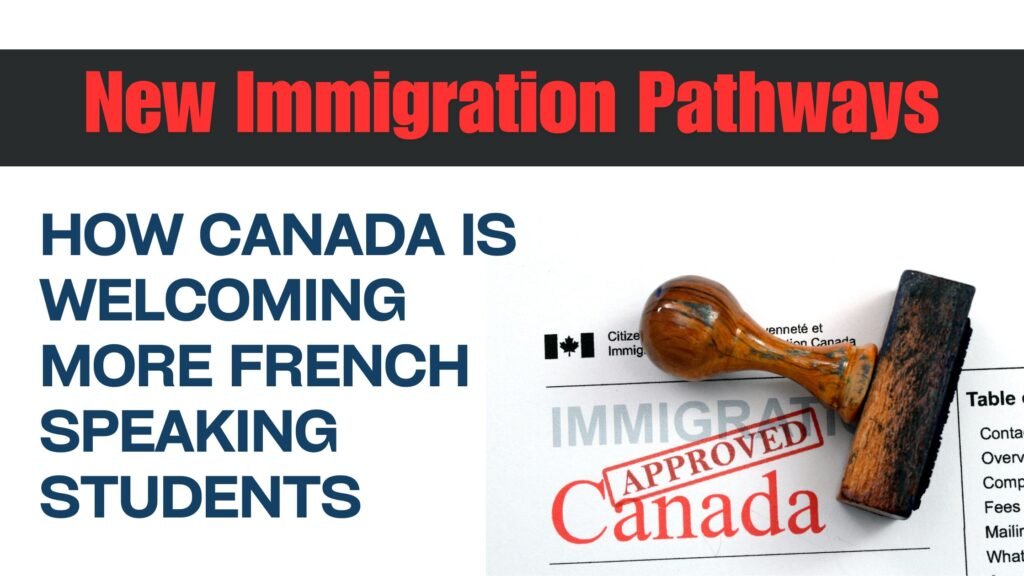Introduction
Did you know that French-speaking international students have several leverages in Canada’s immigration pathways? French is one of Canada’s official languages and is spoken by around 22% of the population, primarily in Quebec and other parts of eastern Canada. According to Immigration, Refugees and Citizenship Canada(IRCC), in 2019, over 62% of principal applicants who landed in Quebec spoke French as a first language.
In this blog, we’ll explore the new immigration pathways that Canada has introduced to attract more French-speaking students, and how this aligns with Canada’s broader goals of diversity, bilingualism, and economic growth. And more importantly, what does this mean for the future of immigration and education in the country?
What are Express Entry draws?
Express Entry draw is a process conducted by Immigration, Refugees and Citizenship Canada (IRCC) to select people from the Express Entry pool, issue invitations to apply(ITAs), and give them permanent residency in Canada. This is the important immigration pathway available for foreigners looking for immigration in Canada. These draws happen every week and during each session, it selects a certain number of Express Entry profiles based on their CRS score.
The CRS (Comprehensive Ranking System) score is a point-based system based on factors like age, language proficiency, work experience, and adaptability. It is used to select the candidates for permanent residency. A higher CRS score indicates a higher ranking and increases the chances of being invited to apply for a permanent residency visa. The latest CRS Score Cut-Off is 394. Check your CRS Score
Effects of Bill C-19 on Immigration Paths
Canada recently passed the Canada Immigration Bill C-19 making amendments to the Immigration Refugee Protection Act (IRPA) that will change the way Express Entry candidates are selected. Before this amendment, the selection was straightforward and solely based on the CRS score. But candidates can now be invited based on “groupings” or categories set out by the Immigration Minister.
The groupings will be chosen based on factors such as employment experience, academic experience, or proficiency in English or French. Paving the way to the Category-based Express Entries instead of traditional point-based Entries. The amendment aims to invite more skilled labor inside the nation as the criteria are also based on the NOC(National Occupational Classification) levels which is a standardized way used by IRCC to to categorize jobs based on skill levels. These changes give leverage to the candidates from Francophone nations and the ones who are proficient in French.
How learning French can leverage you?
Canada’s official bilingualism, with both English and French recognized at the federal level, provides a unique advantage for French-speaking students. They can pursue higher education in their native language while also improving their English skills, making them more competitive in the global job market. It will also help you to improve your CRS score based on your level in the CLB(Canadian Language Benchmarks) test on French language proficiency conducted by the IRCC.
Canada’s immigration policies have become increasingly favorable for French-speaking students. Programs such as the Student Direct Stream (SDS) and the Francophone Mobility Program make it easier for French-speaking students to obtain study permits and eventually transition to permanent residency. Not only for immigration, good French proficiency can help you seek jobs and socialize easily in Canadian society. So, if you are a foreigner looking for immigration in Canada or any Francophone nation, having a good proficiency in French is crucial.
What are the other Programs offered?
Programs such as the Study Permit, Post Graduate Work Permit, and the Quebec Experience Class, among others, have been specifically introduced by Canada to retain French-speaking students. These are among other initiatives in an overall framework of pro-Francophone immigration policy outside Quebec which seeks to increase the Francophone population anywhere in Canada.
- Francophone Mobility Program: It is a program that enables employers who are situated in any province of Canada excluding Quebec to directly hire francophone talents hailing from foreign regions without having to undergo an LMIA process. This has given leverage to French-speaking graduates in the search for a job in Canada and transition to permanent residence.
- Student Direct Stream (SDS): Although the SDS is available to all international students, it targets mostly French-speaking students particularly those from Senegal, Morocco, and Cameroon. The program expedites the process of getting a study permit increasing the attractiveness of Canada even further for such students.
- Francophone Immigration Strategy: Implemented in 2019, this strategy is intended to raise the number of immigrants from francophone countries except Quebec and establish it to be 4. 4% by 2023. Some of the measures within the strategy aim at enhancing the visibility of Canada to French-speaking students such as collaboration with educational stakeholders and marketing the country to the Francophone countries.
- Rural and Northern Immigration Pilot (RNIP): These proposed increase other opportunities for French-speaking students to start a new life and integrate into any part of Canada that they prefer. The RNIP therefore promotes linguistic differences besides contributing to the economic development of the regions by encouraging the main settlement in the rural areas.
Challenges and Future Outlook
While Canada’s efforts to attract more French-speaking students have been largely successful, some challenges need to be addressed:
- Integration: It is important to keep in mind the need of French students to feel belong and are part of the Canadian culture especially where the English language is dominant. This needs identification of special needs having to do with services, languages, and community involvement.
- Retention: Another problem is that many French-speaking students drop out after their studies. Still, many students would like to remain in the country for different reasons. However, the challenges include a lack of jobs in their areas of specialty or a lack of understanding of immigration rules.
- Competition: Canada is challenged by other countries like France and Belgium which also have strong marketing factors and opportunities for French-speaking students. Hence, for Canada to sustain its competitiveness, more efforts need to be made particularly in the areas of immigration and education systems.
Takeaways
The new immigration options for French-speaking students in Canada are a positive development in the right direction toward the improvement of the country’s diversity and multilingualism as well as a boost to the country’s economy and workforce. When Canada reaches out to these students, it is strengthening the student’s culture and language and at the same time, investing in a better tomorrow.
As Canada goes about the process of perfecting and diversifying such avenues to a greater extent, the country will continue to be popular for French-speaking learners thus attracting more students from across the globe.





Leave a Reply